How the NRSC Benefits Your Station
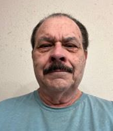
[May 2024] Since 1994, the FCC requires AM stations to take a look at the effect of its transmissions on the broadcast spectrum every year. Some see this as a burden, but as Norm Laramee points out, the procedure has some real benefits that make it, in effect, cheap insurance.
The requirement for an annual NRSC measurement was placed in the Rules by the FCC on June 30, 1994.
FCC Rule 73.1590 states the requirement to make measurements, while FCC Rule 73.44 explains invery specific detail how the measurements must be performed.
Since then, each AM station must do an NRSC measurement each year, not more than 14 months apart. Many stations consider this an expensive burden, but there are some real benefits to complying with the requirement – not the least of which is avoiding a fine.
MULTIPLE ASPECTS OF NRSC
While one might focus solely on the measurement itself, by completing the regulatory compliance, stations can also gain important information on how well their RF system is working.
You might compare the NRSC measurement it to what happens when you take your vehicle in for its periodic service. Those inspection and maintenance fees are not insignificant, but you will get warnings about potential problems – or something that is already needing immediate attention.
Similarly, your NSRC measurement may provide an early warning sign of pending component failure. It may also give you information regarding your program audio or potential interference from other stations that might limit your coverage.
For instance, a failing capacitor can cause one or many spurs, depending upon the slice of bandwidth you are measuring. Or, the test can show that you have no current problems.
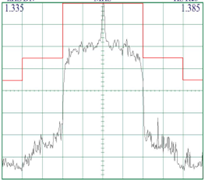
At the same time, as you look at the wider band, to show compliance with the emission limitations, it might look like there is a problem. An experienced engineer will note the location and size of the display, and do extra tests, if necessary to identify carriers from adjacent stations that might have impact.
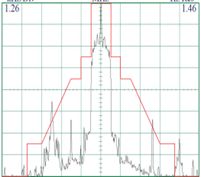
As seen, there are a few stations whose carriers can be seen. Their levels, especially seen over several years, can identify potential interference issues.
Given the importance of this measurement, and a number of ways it might not be done properly by inexperienced persons, finding a competent engineer to do the measurement is essential. Let us see why.
THINGS THAT MIGHT MAKE YOUR NRSC LESS VALUABLE
As with any test measurement, the NRSC should be done with the right gear – and someone who knows how to use it!
For example, when the test is made can be critical. Although not stated specifically under the NRSC rules, just as if you were to make any AM RF field measurements for other purposes, particularly at a distance, you must be aware of the potential for skywave interference.
It is generally understood that as a rule of thumb, do not make measurements until two hours after sunrise and two hours before sunset. While sometimes you can fudge a little since atmospheric conditions can change from time to time, in my experience I have never been able to get much closer than one hour before and after and still get interference free readings.
WHAT ABOUT WEATHER?
Here is a variable that can greatly affect the measurement, but cannot always be predicted ahead of time.
Static discharge from electrical storms even hundreds of miles away will completely ruin any NRSC measurement in the field. This is particularly true when measuring the 200 kHz bandwidth measurement. Over the course of the 10 minutes that it takes to make the measurement, atmospheric noise can definitely raise the noise floor to the point of making the measurement useless.
Depending on the time of the year, traveling across the country to measure many stations at a time can turn into a game of whack-a-mole if you do not plan weeks ahead, weather-wise. Even then, flexibility on the part of the engineer and the station may be essential. Together, you should always check the weather and look for blue skies.
ANOTHER POINT WHERE EXPERIENCE CAN BE CRUCIAL
Where the test is made can be a real balance of distance and test integrity.
The FCC Rules clearly state, “Measurements made of the emissions of an operating station are to be made at ground level approximately 1 kilometer from the center of the antenna system.”
In practice, I found early on that this is entirely impractical. The AM noise floor in the real world is much higher today than when the Rules were first implemented – and continue to increase incrementally every year. At least that has been by my personal continued observation.
For that reason, this is the only part of the NRSC Rules that I have not always been able to fully comply with and at the same time obtain bandwidth measurements that are meaningful. Instead, depending on the power level of a given station, I have to find a location clear of any electromagnetic generators or obstructions that is close enough to the antenna site to give me a useable S/N ratio to satisfy the rest of the NRSC measurement rules.
Such a location invariably ends up being much closer than the 1-kilometer point called for in the Rules.
To help illustrate this, you look at this graphic from an NRSC report. You will see the Site Location Map, which shows two circles centered around the geographic center of the antenna array.
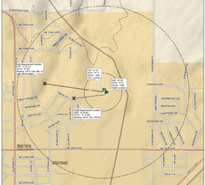
The outer circle indicates where the 1-kilometer point is located and the inner circle shows the distance to the wavelength point. Sometimes it is prudent to use two separate points to ensure the results are valid. At the same time, you never want to get closer than one wavelength, as you will end up with a
distorted and inaccurate measurement of the radiated signal.
All-in-all, if you add the variables of weather, long distances between measurement locations, and local sunrise/sunset times, now you can be talking whack-a-mole on steroids. Nevertheless, with experience an accurate measurement can be made – one that will allow a station to really know how the RF system is operating.
https://henryeng.com
SOMETHING ELSE TO CONSIDER
There is a service that I provide that you may not have seen before.
That is the 10-minute modulation snapshot. Although not required as part of the NRSC Rules, modulation limits are prescribed elsewhere in the FCC Rules. Regardless, I added this feature to my NRSC measurement reports because it was easy to do and could possibly provide some degree of education to station managers and newbie local engineers. It also provides me with a tool for additional insight when measuring a station. Oftentimes I am able to easily correlate overmodulation with out of band emissions when looking at the RF spectrum measurements.
From what I have seen over the years, many stations are grossly in violation of both the positive and negative limits, and yet do not have a clue (sadly, in some cases, they do not even care.)

Also, apart from absolute levels displayed, if you understand how to read the graphic display, you can easily see an approximation of the audio density (compression/loudness) and other aberrations caused by transmitter modulator and/or antenna system issues.
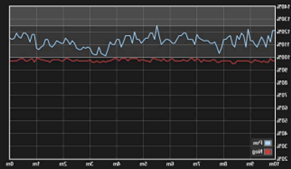
TIME AND EXPERIENCE
By way of reference, I have been doing NRSC measurements for well over 20 years, for stations in at least 13 states.
With a client list that has grown (and fluctuated) over the years, it was important to develop both a well-planned procedure and travel route to provide the best services possible at the best possible price.
At the same time, as you can well imagine, the jump in fuel and hotel prices in the last several years have been challenging, but those are not the only challenges to providing what is really a very important diagnostic in a time when many stations do not have the staff nor test gear to know for sure they are in compliance.
THE “WHEN” AGAIN
Given the large number of measurement destinations scattered over thousands of miles, a finite window of opportunity (in hours) between local sunrise & sunset each day, and the need to minimize weather related interference by looking for a time of the year that balances all of these concerns, I have established an annual period of NRSC measuring that begins on or about Labor Day.
Without belaboring the mechanics of it all, over the years this has turned out to be overall the best time of the year to “git er done.”
Bottom line: find an engineer that is recommended to you to trust and do your NRSC measurements each year. If you do this, you may well find it was cheap insurance – not to mention being in full compliance with the FCC.
– – –
Norm Laramee is a radio engineer based in Broken Arrow, OK. He has over 60 years of experience in fulltime engineering, studio and transmitter construction, and as Director of Engineering for several companies. You can contact Norm at norm@diproservices.com
– – –
Would you like to know when more articles like this are published? It will take only 30 seconds to
>click here and add your name to our secure one-time-a-week Newsletter list.
>Your address is never given out to anyone.
